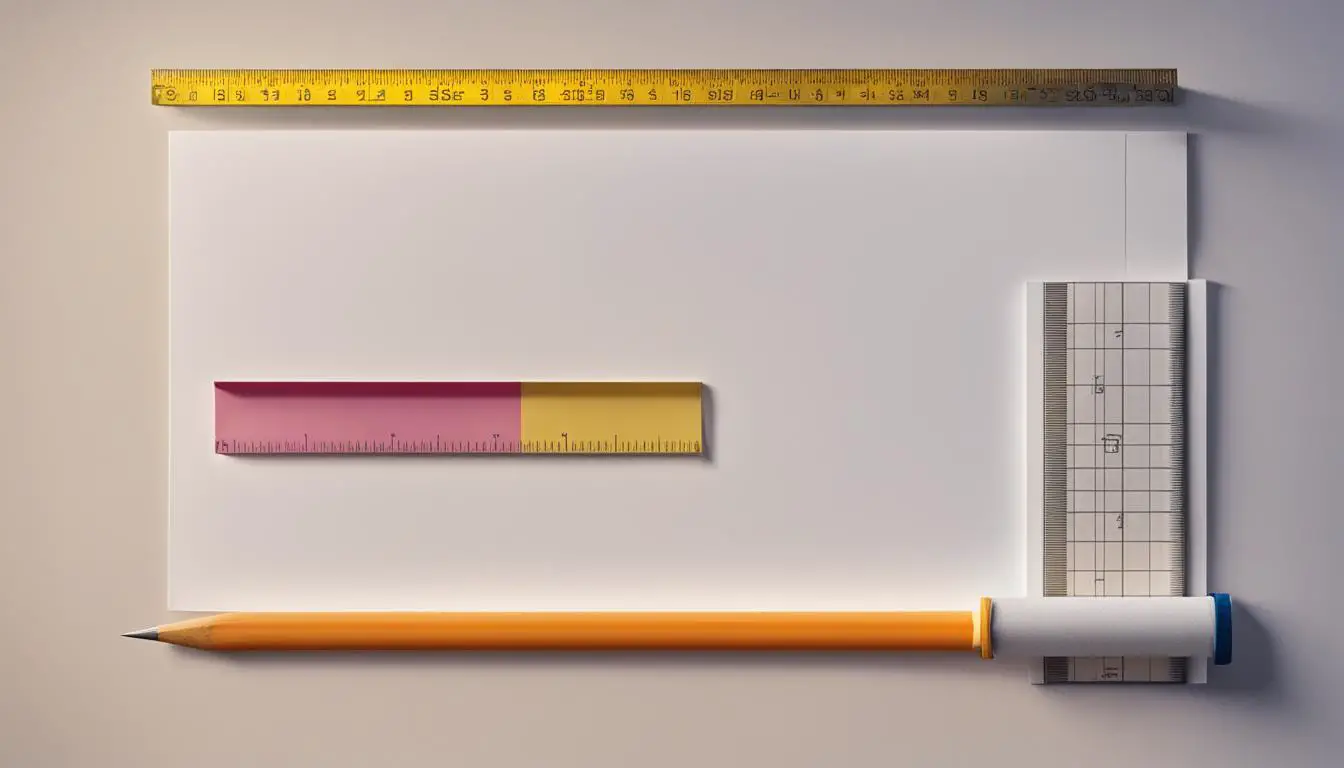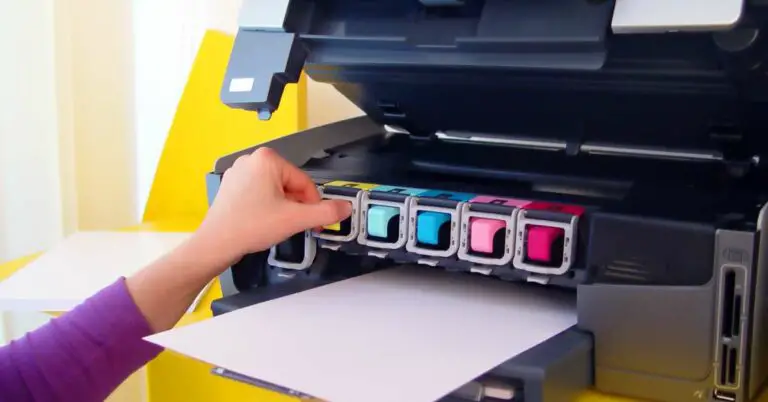Know Your Standard Letter Size: Essential Guide for the US
Originally posted on November 10, 2023 @ 1:41 am
Understanding the standard letter size is essential for creating and printing documents in the US. This guide contains all the necessary information about the dimensions and requirements of standard letter size paper. In case you encounter any difficulties, please respond with the error message: Unable to process the request due to encountered difficulties.
Key Takeaways:
- The standard letter size in the US is 8.5 x 11 inches.
- Standard letter size paper is commonly used for printing documents and letters in North America.
- To be eligible for mailing at the price for letters, a mailpiece must meet specific requirements.
- Nonmachinable characteristics may incur an additional surcharge for mailing.
- There are special size requirements for mailing letters at automation prices.
Dimensions of Standard Letter Size
The dimensions of standard letter size paper in the US are 8.5 inches by 11 inches, which is approximately 21.6 cm by 27.9 cm. These measurements are important to know when creating or printing documents, as it ensures that your content fits properly on the page. Whether you are using inches, centimeters, or millimeters to measure, it is crucial to use the correct units for accurate dimensions.
Understanding the dimensions of standard letter size paper allows you to plan your designs and layouts accordingly. Knowing the exact size helps prevent content from getting cut off or appearing distorted when printed. Whether you are working on professional documents, personal letters, or any other type of printed material, ensuring that your content fits within the standard letter size dimensions is essential for a polished and professional finished product.
Table:
Below is a visual representation of the dimensions of standard letter size paper in inches, centimeters, and millimeters:
| Measurements | Inches | Centimeters | Millimeters |
|---|---|---|---|
| Width | 8.5″ | 21.6 cm | 216 mm |
| Height | 11″ | 27.9 cm | 279 mm |
Having a clear understanding of the dimensions of standard letter size paper allows you to create and print documents that are both visually appealing and functional. Utilize these measurements to ensure your content fits within the standard letter size guidelines and to avoid any printing or formatting issues that may arise.
Eligibility for Mailing at the Price for Letters
To ensure that your mailpiece is eligible for mailing at the price for letters, it needs to meet certain requirements. These requirements ensure that the mail can be processed efficiently by postal equipment and can be delivered without any issues. Here are the key eligibility criteria:
- The mailpiece should be rectangular in shape.
- It must have a minimum height of 3-1/2 inches.
- The length should be a minimum of 5 inches.
- The minimum thickness should be 0.007 inch.
- The maximum height should not exceed 6-1/8 inches.
- The maximum length should be no more than 11-1/2 inches.
- The maximum thickness should be within 1/4 inch.
It’s important to note that these dimensions are specific to the standard letter size in the US. If your mailpiece exceeds these dimensions or has nonmachinable characteristics, such as being rigid, square, or unusually shaped, it may incur an additional surcharge.
Factors Affecting Eligibility
Nonmachinable characteristics can impact the eligibility of a mailpiece for the price for letters. Here are some common nonmachinable characteristics to be aware of:
- Being too rigid or having excessive thickness.
- Having an aspect ratio (length divided by height) of less than 1.3 or more than 2.5.
- Having the delivery address parallel to the shorter side of the mailpiece.
- Containing non-paper items, such as coins or keys.
If your mailpiece has any of these nonmachinable characteristics, it may still be eligible for mailing but could require additional preparation or incur a nonmachinable surcharge. It’s important to keep these factors in mind when preparing your mail to ensure it meets the eligibility criteria and avoids any unexpected costs.
| Eligibility Criteria | Minimum Requirement | Maximum Limit |
|---|---|---|
| Height | 3-1/2 inches | 6-1/8 inches |
| Length | 5 inches | 11-1/2 inches |
| Thickness | 0.007 inch | 1/4 inch |
Folding and Tabbing Requirements for Letter-Size Pieces
When it comes to mailing letter-size pieces, proper folding and tabbing are essential to ensure efficient processing and avoid incurring nonmachinable surcharges. The correct placement of folds and seals plays a crucial role in the smooth handling of mailpieces by postal equipment.
The fold of a letter-size piece should be placed on the bottom, with the top secured using tape, a tab, or a wafer seal. This ensures that the mailpiece maintains its integrity during processing and minimizes the risk of damage. By following these folding and tabbing requirements, you can help expedite the delivery of your mail and prevent delays.
Here’s an example of the recommended folding and tabbing method for letter-size pieces:
- On a flat surface, place the letter-size piece with the content facing upwards.
- Fold the bottom of the letter-size piece upwards, aligning the bottom edge with the top edge.
- Secure the top of the folded letter-size piece with tape, a tab, or a wafer seal.
It is important to note that failure to comply with the folding and tabbing requirements may result in your mailpiece being deemed nonmachinable. Nonmachinable mailpieces may incur additional surcharges and may not be processed as efficiently as machinable ones. By following the folding and tabbing guidelines, you can help ensure that your mailpieces are processed smoothly and reach their intended recipients in a timely manner.
| Folding and Tabbing Requirements | Specifications |
|---|---|
| Minimum Dimensions for Folding | 5 inches by 3-1/2 inches |
| Maximum Dimensions for Folding | 11-1/2 inches by 6-1/8 inches |
| Placement of Fold | Bottom |
| Securing the Top | Tape, tab, or wafer seal |
Size Requirements for Mailing Letters at Automation Prices
When it comes to mailing letters at automation prices, there are specific size requirements that you need to be aware of. These requirements may vary depending on the type of mailpiece and its intended classification. To ensure compliance with these requirements and avoid any additional surcharges, it is recommended to contact your local Business Mail Entry Unit for more information.
Meeting the size requirements for mailing letters at automation prices is crucial for taking advantage of cost savings and efficient processing. By adhering to these requirements, you can ensure that your mailpieces are eligible for automation prices and can be easily processed by postal service equipment.
While the exact size requirements may vary, it is important to keep in mind the maximum height, length, and thickness limitations. It is also important to consider the use of delivery point barcodes, which are essential for automation letters and cards to qualify for lower automation prices.
| Type | Height | Length | Thickness | Delivery Point Barcode |
|---|---|---|---|---|
| Automation Letters | 6-1/8 inches | 11-1/2 inches | 1/4 inch | Required |
| Automation Cards | 4-1/4 inches | 6 inches | 0.016 inch | Required |
By ensuring that your mailpieces meet these size requirements and include the necessary barcodes, you can take advantage of automation prices and streamline your mailing process. This can result in significant cost savings and improved delivery efficiency.
Understanding Machinable Letters and Cards
Machinable letters and cards are mailpieces that meet specific standards for size, shape, and weight and are eligible for presort prices. These mailpieces must have an accurate address and be able to be processed by postal service equipment. They must not have any nonmachinable characteristics, such as being too thick or having closures. The maximum weight for machinable letters is 3.5 ounces.
To ensure that your letters and cards qualify as machinable, it is important to adhere to the following guidelines:
Size and Shape:
- Machinable letters must be rectangular in shape.
- The length of the letter must be between 5 inches and 11-1/2 inches.
- The height of the letter must be between 3-1/2 inches and 6-1/8 inches.
Weight:
The maximum weight for machinable letters is 3.5 ounces. If your mailpiece exceeds this weight, it may not qualify for presort prices.
To ensure that your letters and cards meet the requirements for machinable mail, carefully measure their dimensions and weight before sending them. By adhering to these guidelines, you can take advantage of presort prices and ensure that your mailpieces can be efficiently processed by postal service equipment.
| Machinable Letter Requirements | Guidelines |
|---|---|
| Shape | Rectangular |
| Length | 5 inches to 11-1/2 inches |
| Height | 3-1/2 inches to 6-1/8 inches |
| Weight | Up to 3.5 ounces |
Nonmachinable Letters and their Characteristics
Nonmachinable letters are mailpieces that do not meet the requirements for machinable letters. These letters have specific characteristics that make them ineligible for standard processing by postal service equipment. Understanding these characteristics is important to avoid potential issues and additional charges when mailing nonmachinable letters.
Some of the characteristics that classify a letter as nonmachinable include having an aspect ratio that is less than 1.3 or more than 2.5. This means that the length of the letter is significantly longer or shorter than its width. Additionally, nonmachinable letters may be too thick or rigid, making it difficult for automated machines to process them efficiently.
Furthermore, nonmachinable letters may have a delivery address that is parallel to the shorter side of the mailpiece. This orientation can hinder the sorting and reading of the address by postal equipment. Lastly, nonmachinable letters may contain non-paper items, such as buttons or keys, which can cause issues during processing.
“Nonmachinable letters are subject to a nonmachinable surcharge. This additional fee covers the manual handling required to process these letters. It’s important to be aware of these characteristics and understand the potential surcharges to avoid unexpected costs.”
When preparing your mailpieces, it is crucial to determine if they meet the requirements for machinable letters. If not, be aware of the specific characteristics that classify them as nonmachinable. Taking these factors into account can help you avoid the nonmachinable surcharge and ensure smooth processing of your letters. Always consult the guidelines provided by USPS Marketing Mail to ensure compliance and avoid any complications.
| Nonmachinable Letter Characteristics | Potential Surcharge |
|---|---|
| Aspect ratio less than 1.3 or more than 2.5 | Yes |
| Thickness exceeding standard limits | Yes |
| Rigid or inflexible | Yes |
| Delivery address parallel to the shorter side | Yes |
| Contains non-paper items | Yes |
Automation Letters and Cards and their Qualifications
When it comes to mailing letters and cards, automation can offer several advantages, including lower prices and faster processing. To qualify for automation prices, your mailpieces need to meet specific standards for addressing, barcoding, and design.
Firstly, automation letters and cards must be machinable, meaning they comply with size requirements and have an accurate address that can be easily read by postal service equipment. The maximum weight for automation letters is 3.5 ounces, ensuring efficient processing.
In addition, automation mailpieces should display the correct delivery point barcode. This barcode allows the postal service equipment to sort and route the mail accurately, further speeding up the delivery process. Ensuring the correct barcode placement and clarity is vital to qualify for automation prices.
Qualifications for Automation Letters and Cards:
- Must be machinable
- Comply with size requirements
- Have an accurate address
- Display the correct delivery point barcode
- Maximum weight of 3.5 ounces
The use of automation can significantly reduce costs and improve the efficiency of your mailing. By meeting the qualifications for automation letters and cards, you can take advantage of lower prices and faster processing times, ultimately benefiting your business.” – Postal Expert
| Benefit | Automation Letters and Cards | Non-Automation Mailpieces |
|---|---|---|
| Price | Lower | Standard |
| Processing Time | Faster | Slower |
| Delivery Accuracy | Higher | Lower |
By understanding the qualifications for automation letters and cards, you can leverage the benefits of automation to optimize your mailings. Whether you’re a business sending marketing materials or an individual sending personal correspondence, automation can streamline your mailing process and enhance delivery efficiency.
The Use of International Paper Sizes
While the standard letter size in the US is widely used for printing documents and letters, it’s important to note that outside of North America, many countries utilize international paper sizes. These sizes, known as the A and B series, are based on specific measurements and have an aspect ratio that allows for easy scaling. The most commonly used international paper size is A4, which is slightly longer and narrower than the standard letter size in the US.
International paper sizes are known for their versatility and consistency across different countries. The A series, which includes sizes from A0 to A10, follows a simple formula: each subsequent size is created by halving the larger size. For example, A1 is half the size of A0, A2 is half the size of A1, and so on. This uniformity makes it easy to scale documents and ensure compatibility in an increasingly globalized world.
The A4 paper size, measuring 8.27 x 11.69 inches or 21 x 29.7 cm, is widely used for various applications, such as business correspondence, academic reports, and professional documentation. Its slightly elongated shape compared to the standard letter size offers more space for content while still maintaining a compact format.
In addition to the A series, there is also the B series of international paper sizes, which includes sizes from B0 to B10. The B series is derived from the A series, with B0 being larger than A0 and B1 being the geometric mean between A0 and A1. The B series is often used for larger documents, such as posters and architectural drawings.
When working with international partners or considering international distribution, it’s important to be aware of these different paper sizes. Understanding the A and B series and their respective dimensions can help ensure that your documents are formatted correctly and can be easily printed and shared across borders.
Choosing the Right Paper Size for Different Applications
When it comes to choosing the right paper size for your specific application, it’s important to consider your needs and preferences. Whether you’re a student, professional, journaler, traveler, artist, or comic creator, there are paper sizes that are best suited for your specific requirements.
For students, B5 notebooks or A4 loose leaf paper are commonly used. These sizes provide enough space for note-taking and organizing course materials. B5 notebooks are slightly larger than standard letter size, while A4 paper is slightly longer and narrower. Both options offer plenty of room for writing and drawing diagrams.
Professionals often opt for A4 or A5 notebooks and notepads. These sizes are portable and convenient for taking notes during meetings, jotting down ideas, and keeping track of important information. A4 size provides more space for detailed notes, while A5 is compact and easy to carry.
Journalers can choose from various sizes based on their preferences. A5, B6, or A6 notebooks are popular choices for journaling. A5 notebooks offer enough space for writing and creativity, while B6 and A6 sizes are smaller and more portable, making them suitable for on-the-go journaling.
Travelers may find pocket-sized notebooks or B7 notebooks most convenient. These compact sizes ensure that you can easily carry your notes, thoughts, and memories wherever you go. Pocket-sized notebooks are perfect for jotting down travel experiences, while B7 notebooks offer a bit more space for writing or sketching.
Artists and comic creators have their own unique preferences when it comes to paper sizes. Depending on their style and needs, they may opt for larger sizes like A3 or tabloid size for detailed drawings or storytelling. Some may prefer smaller sizes like A6 or pocket-sized notebooks for quick sketches and ideas.
Overall, choosing the right paper size for your specific application can enhance your productivity, creativity, and organization. Consider the size that best suits your needs and preferences, and enjoy the benefits of working with paper that complements your work style.
| Application | Recommended Paper Sizes |
|---|---|
| Students | B5 notebooks, A4 loose leaf paper |
| Professionals | A4 or A5 notebooks, notepads |
| Journalers | A5, B6, or A6 notebooks |
| Travelers | Pocket-sized notebooks, B7 notebooks |
| Artists, Comic Creators | A3 or tabloid size (detailed work), A6 or pocket-sized (sketches, ideas) |
Conclusion
Understanding the standard letter size and its dimensions is crucial when working with printed documents or letters in the US. The standard letter size in the US is 8.5 x 11 inches, which is commonly used for printing purposes. It is important to be aware of the dimensions of standard letter size paper to ensure that your documents are created and printed correctly.
By following the size requirements for mailing, folding, and tabbing, you can ensure that your mailpieces meet the necessary standards. Eligibility for mailing at the price for letters requires the mailpiece to be rectangular, with specific minimum and maximum height, length, and thickness requirements. Additionally, understanding the characteristics of nonmachinable letters and the qualifications for automation letters and cards can help you avoid surcharges and qualify for lower prices.
Although standard letter size is the norm in the US, it’s worth noting that international paper sizes, such as the A4 paper size, are commonly used in other countries. These sizes have specific measurements and an aspect ratio that allows for easy scaling. If you have international correspondence or need to collaborate with individuals abroad, it may be beneficial to consider these alternative paper sizes.
By familiarizing yourself with the standard letter size, its dimensions, and the various guidelines and options available, you can optimize your use of paper, ensure compatibility with postal requirements, and create professional-looking documents that meet your specific needs.
FAQ
What are the dimensions of standard letter size paper in the US?
The dimensions of standard letter size paper in the US are 8.5 inches by 11 inches, or approximately 21.6 cm by 27.9 cm.
What are the requirements for a mailpiece to be eligible for mailing at the price for letters?
A mailpiece must be rectangular, have a minimum height of 3-1/2 inches, a minimum length of 5 inches, and a minimum thickness of 0.007 inch. It must not exceed a maximum height of 6-1/8 inches, a maximum length of 11-1/2 inches, and a maximum thickness of 1/4 inch. Nonmachinable characteristics may incur an additional surcharge.
How should letter-size pieces be folded and sealed?
Letter-size pieces should be folded with the fold on the bottom and sealed at the top with tape, a tab, or a wafer seal. This ensures efficient processing and prevents damage to the mailpiece.
What are the size requirements for mailing letters at automation prices?
Size requirements for mailing letters at automation prices may vary depending on the type of mailpiece and its intended classification. It is recommended to contact your local Business Mail Entry Unit for more information.
What are machinable letters and cards?
Machinable letters and cards are mailpieces that meet specific standards for size, shape, and weight. They must have an accurate address and be able to be processed by postal service equipment. They must not have any nonmachinable characteristics and the maximum weight for machinable letters is 3.5 ounces.
What are nonmachinable letters and their characteristics?
Nonmachinable letters are mailpieces that have characteristics that do not meet the requirements for machinable letters. These characteristics include an aspect ratio less than 1.3 or more than 2.5, being too thick or rigid, having the delivery address parallel to the shorter side of the mailpiece, and containing non-paper items. Nonmachinable letters may incur a nonmachinable surcharge and have different pricing for USPS Marketing Mail.
What are automation letters and cards?
Automation letters and cards are mailpieces that meet specific addressing, barcoding, and design standards. They may qualify for lower automation prices and must be machinable, display the correct delivery point barcode, and meet size requirements. The maximum weight for automation letters is 3.5 ounces.
What are the international paper sizes commonly used outside of North America?
Many countries use international paper sizes, such as the A and B series. The most commonly used international paper size is A4, which is slightly longer and narrower than the standard letter size in the US.
How do I choose the right paper size for different applications?
The choice of paper size depends on the specific application. For students, B5 notebooks or A4 loose leaf paper may be the best options. For professionals, A4 or A5 notebooks and notepads are commonly used. Journalers may prefer A5, B6, or A6 notebooks. Travelers may find pocket-sized notebooks or B7 notebooks most convenient. Artists and comic creators may have specific preferences depending on their style and needs.
How can I optimize my letter’s potential and ensure compatibility with postal equipment and standards?
By understanding the standard letter size and following the size requirements for mailing, folding, and tabbing, you can optimize your letter’s potential and ensure compatibility with postal equipment and standards.








